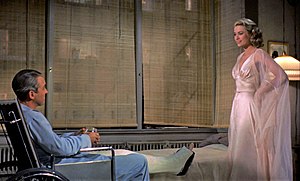
How the Rear Window Movie Poster Captured a Generation’s Imagination
Table of Contents
Introduction to a Cinematic Masterpiece
Alfred Hitchcock’s rear window movie poster remains a cinematic marvel. The movie poster alone has cemented its place in film history. It’s not just a poster; it’s a cultural icon that captivated audiences and continues to inspire.
Design Rear Window Movie Poster
The “Rear Window” poster is a visual masterpiece. Its use of contrasting colors and striking imagery instantly grabs attention. The bold red and black hues create a sense of mystery and intrigue. These elements perfectly reflect the suspenseful nature of the film.
Symbolism in the Poster
The poster features James Stewart peering through binoculars. This imagery symbolizes the film’s voyeuristic theme. It invites viewers to partake in Stewart’s world, adding a layer of psychological depth. The poster’s ability to convey this complex theme visually is a testament to its design brilliance.
Impact on Pop Culture
The poster’s influence extends beyond the film industry. It has inspired countless artists and designers. Its iconic status has been cemented through various homages in pop culture. From television shows to modern films, the “Rear Window” poster’s impact is undeniable.
The Role of Typography
Typography plays a crucial role in the poster’s effectiveness. The bold, sans-serif font used for the title adds to the overall impact. It’s clean, straightforward, and complements the poster’s visual elements. This typographic choice enhances readability and ensures the title stands out.
Emotional Connection with the Audience
The poster creates an emotional connection with the audience. It promises suspense, drama, and excitement. This emotional appeal is a significant factor in its enduring popularity. It resonates with viewers, drawing them into the world of “Rear Window.”
Marketing Brilliance
From a marketing perspective, the poster is a masterclass. It successfully captures the essence of the film in a single image. This efficiency in communication has contributed to the film’s lasting legacy. The poster not only promotes but also tells a story, which is a rare achievement.
Legacy and Continued Relevance
Decades after its release, the “Rear Window” poster continues to be relevant. It’s studied in design schools and admired by film enthusiasts. Its timeless appeal lies in its perfect blend of art and marketing. The poster remains a benchmark for movie advertising.
Influence on Modern Poster Design
The “Rear Window” poster has had a significant influence on modern poster design. Contemporary designers often draw inspiration from its use of color, composition, and typography. The poster’s ability to convey a narrative through minimalistic yet powerful visuals is a lesson in effective design. Modern movie posters frequently employ similar techniques, aiming to create an immediate and lasting impression on potential audiences.
The Collector’s Market
The “Rear Window” poster is a prized item in the collector’s market. Original prints of the poster are highly sought after by collectors and film enthusiasts alike. Its value has increased over the years, reflecting its status as a piece of cultural and artistic history. Auctions featuring this iconic poster often see significant interest and high bids, underscoring its enduring appeal and importance.
Educational Value in Design Studies
In design studies, the “Rear Window” poster is often used as a case study. It exemplifies principles of effective visual communication and marketing. Students learn about the importance of color theory, composition, and typography through its analysis. The poster serves as a perfect example of how a well-designed promotional material can transcend its initial purpose, becoming a lasting piece of cultural heritage.
Influence on Other Art Forms
Beyond poster design, the Rear Window Movie Poster has also influenced various other art forms. Photographers, painters, and graphic artists have all drawn inspiration from its striking visual elements. The poster’s composition and use of color have been replicated in numerous artistic projects. This cross-disciplinary impact highlights the poster’s versatility and its role as a source of creative inspiration. Its legacy continues to thrive as new generations of artists reinterpret its classic design in innovative ways.
Conclusion: A Timeless Icon
The Rear Window Movie Poster is more than just a promotional tool. It’s a piece of art that has captured the imagination of generations. Its design elements, symbolic imagery, and emotional appeal make it a timeless icon in cinematic history.